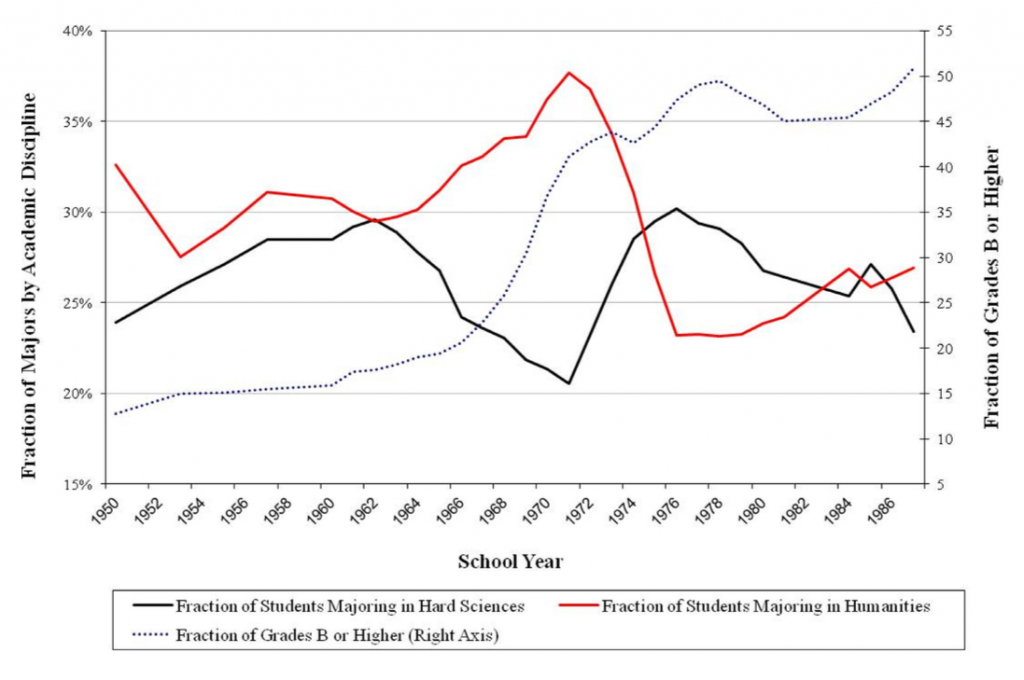
What is behind college grade inflation? A new study finds students are enrolling in easier subjects, while some faculty may be handing out undeserved high marks.
The issue: Grade point averages at American colleges have risen dramatically in recent decades, from a 2.5 (just above a C+) in 1960 to 3.1 (better than a B) in 2006, according to a widely cited academic’s measure. Any seasoned student knows which professors are most generous at the end of the semester. But have professors grown soft, or are other factors at play?
An academic study worth reading: “Measuring Inflation in Grades: An Application of Price Indexing to Undergraduate Grades,” published in Economics of Education Review, 2016.
Study summary: Researchers have shown that grades in the humanities and social sciences tend to be higher than in the natural sciences.
Rey Hernandez-Julian of the Metropolitan State University of Denver and Adam Looney of The Brookings Institution, a think tank, examine grade inflation with an economist’s toolbox. They look for inflation much like an economist would calculate a change in consumer prices, by controlling for variables they can measure, such as students’ class choices, standardized test scores, gender and age. The method provides “a way to decompose overall increases in grades into those components explained by changes in student characteristics and their course choices.”
They apply their methods to 20 years of data for 86,000 students – including full transcripts and SAT admission scores – at Clemson University, a large, selective public school in South Carolina that the authors feel is nationally representative in terms of its rising grades and selectivity of students. During that period (1982 to 2001), Clemson students’ average GPA rose 0.32 points, from 2.67 to 2.99 – which is on a par with GPA increases across the United States. Clemson students’ average SAT scores rose 44 points over that period. To compare courses at different points in time, they matched classes based on department, the class level as indicated by its call number, and course description.
Hernandez-Julian and Looney ask “what would grades have been in 2001 if those students took the same classes and had the same characteristics and qualifications as students in 1982?” But the authors admit they are unable to measure changes in student effort or in the rigor of course material, which could also contribute to higher average grades. In an appendix, they also look at Harvard undergraduates’ grades.
Findings:
- Over the study period, enrollment increased in departments that had historically awarded higher grades (these were largely in the humanities). Enrollment fell in departments that historically awarded lower grades (math, physics and engineering).
- More than half the increase in average grades is due to students choosing different courses and to higher-quality students enrolling at Clemson.
- By department, Speech & Communications and Spanish saw the highest increase in enrollment, rising 1.9 percent and 1.5 percent respectively over the 20 years. Mathematical Sciences saw the largest drop in enrollment, a 2.9 percent decline over the same period.
- The average grade in Speech & Communications is 0.38 above the university GPA; in Spanish it is 0.2 above; in Mathematical Sciences it is 0.41 below. Those numbers fit patterns observed at other schools.
- After controlling for choice of classes (department) and student characteristics (SAT scores, age and gender), they find that about 53 percent of grade inflation disappears.
- Rising SAT scores alone account for roughly 25 percent of the increase in GPAs.
- Average GPAs increased by about 0.018 grade points per year, slightly faster after 1989.
- In 1982, about 24 percent of grades given at Clemson were A’s. In 2001, A’s accounted for 38 percent of all grades. If the school had been as selective in 1982 as it was in 2001, about 30 percent of grades in 1982 would have been A’s.
- Despite these findings, a large part of the increase in grades is “unexplained” and “a relaxation of grading standards may also be an important contributor to rising grades.”
- Women perform better than men, are enrolling in greater numbers than several decades ago, and tend to enroll in “easier-grading departments,” which could explain some of the increase in humanities and social sciences students.
- Grades and course enrollment at Harvard College fit the same patterns. The authors add that the Vietnam War era of the late 1960s and early 1970s was an outlier (see chart below). At that time, “when low grades could cause students to be draft eligible, the share of students concentrating in hard sciences fell by 30 percent; most of those students shifted to easier-grading humanities.”

Helpful resources:
- Gradeinflation.com is a widely cited measure of nationwide GPA trends tracked by Stuart Rojstaczer, a former professor at Duke University.
- The National Center on Educational Statistics monitors college enrollment and other data nationwide.
Other research:
- This 2010 paper in Economic Inquiry found that students appear to study 50 percent more in classes where they expect the class average to be a C rather than an A.
- Grade inflation hurts a school ‘s reputation and is contagious, argues this 2007 paper.
- This 2010 paper in Education Finance and Policy looks at incentives and merit scholarships.
- The Journal of Economic Perspectives, in 2009, reviewed Cornell University’s attempts to tackle grade inflation.
Keywords: University, college, grades, undergraduate, inflation, education reform, easy A
